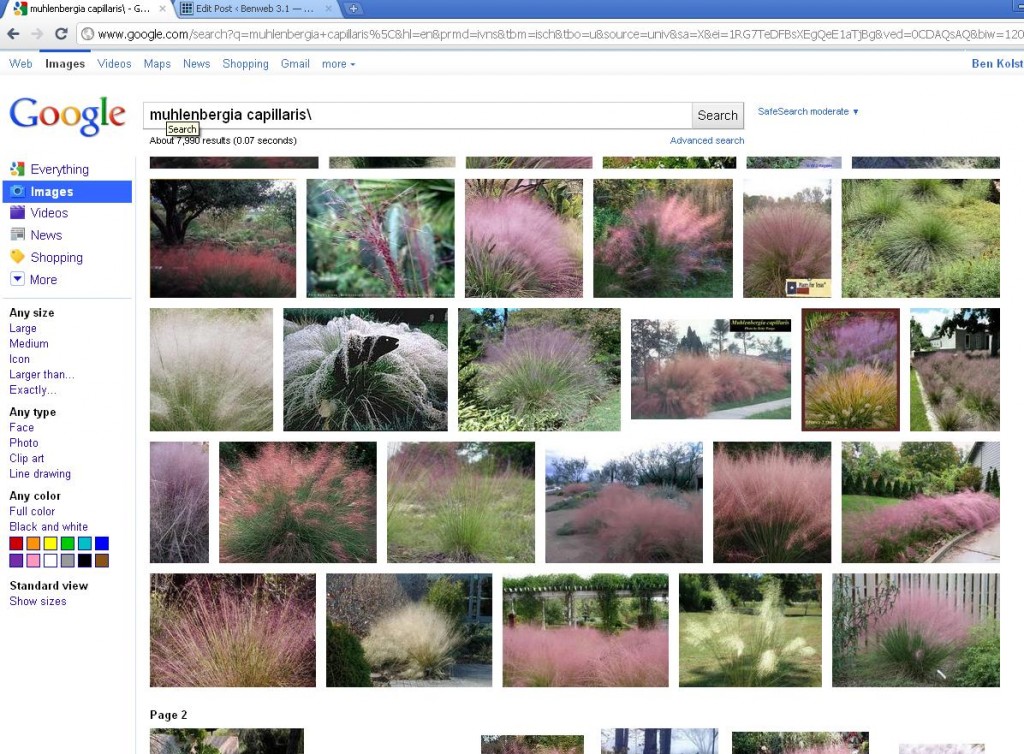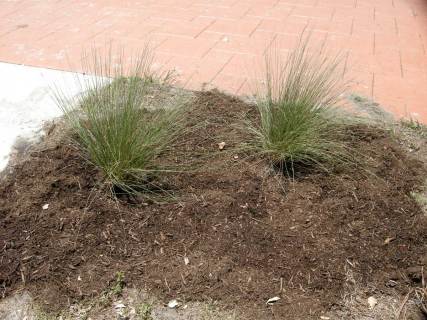I have to begin by quoting the description of Muhlenbergia capillaris (Gulf muhly, Hairawn muhly, Muhly grass) from the UF/IFAS Identification Deck: Grasses, Sedges, and Rushes of Wetlands (1999), because it reminds me of a song I listened to years ago as a rebellious teenager (some twenty years after the original singer, a rebellious youth, died; I tend to live in the past):
Gulf muhly grass may be recognized in summer by the purple haze created by its many large, gauzy inflorescences.
Of course, the UF/IFAS card deck doesn’t cite Jimi, but I’m sure Victor Ramey had him in mind when he wrote/reviewed/edited that plant description.
For those of you who don’t know muhly grass, it’s one of the more common native bunch grasses in the horticultural trade, which means it’s readily available. When I was at NuTurf the other day picking up mulch to supplement the plants I picked up at the FNPS auction, a couple of bunches of hairy muhly made their way into my garden cart, and I was too taken by the possibilities they presented to request that they leave. So I was forced to pay for them and bring them home.
My acquaintance with this grass goes back some years; I know for a fact, as the descriptions in all the books say, that the leaf blades of this grass are tightly rolled and very stiff. I know, because tightly rolled and very stiff equals very pokey, as I discovered—ouch!—right before the Christmas Bird Count in 2009. I had been weeding around a couple of clumps in the backyard at the old house, and darned if I didn’t come away crying like a baby and needing an eye patch for a couple of days! When I mentioned it to native plant guru Rob Hopper at the CBC compilation later, he allowed as to how he (or maybe a friend of his; I don’t actually recall) has actually been sent to the emergency room as a result of run-ins with this innocent-seeming species! Always wear your sunglasses when gardening!
Here is a snapshot of the two new bunches, set right in the corner of the front driveway as a nice accent:
As you can see, I need to work harder to take interesting pictures of plants. But there are many lovely images of muhly grass available on the web; here is a snapshot of the Google image search for them:

For those of you who are interested, Gulf muhly is in the Cynodonteae (Bermudagrass) tribe of grasses, 21 genera of which occur in Florida, making it the largest tribe (by genera, not species) in the state. Muhlenbergia is named for Pennsylvania-born botanist Gotthilf Heinrich Ernst Muhlenberg (1753-1815).
I found all that out from my favorite library book, Walter Kingsley Taylor’s A Guide to Florida Grasses, which goes on to say, in case you speak graminology, that, for the variety I have,
awns (if at all present) on the glumes to 4 mm long. The lemmas lack conspicuous setaceous teeth and lemma awns get to 13 mm or more.
Got it?
Glumes, hmmm, lemme see. A glume is one of a pair of dry membranous bracts (sterile modified leaves, according to Taylor) at the base of a spikelet of grass. Lemmas, lemme see. Analemma, I know what that is (the figure 8 traced by the noon sun in the sky over the course of a year). So if that’s what an analemma is, a lemma must be, must be, well, I give up. Turns out it’s the outermost bract at the base of a spikelet of grass; Taylor’s glossary tells me that it “[encloses] the palea and grass floret.”
Here’s a picture from Wikipedia, which might help:

So by all means, go forth and plant muhly grass, but be careful when you weed it!
References:
Taylor, W. K. (2009). A guide to Florida grasses. Gainesville: U P of Florida.

